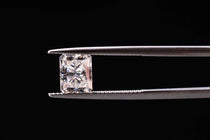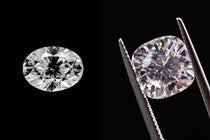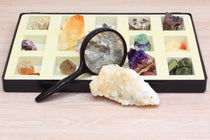When shopping for diamonds, understanding pricing is crucial, especially since it's not always straightforward. A common milestone choice for many is the 1/2 carat diamond, popular for its balance of size and affordability. The price of a 1/2 carat diamond is influenced by several factors, including the four Cs—cut, clarity, color, and carat weight—each playing a significant role in the final cost.
The 1/2 carat size is desirable because it offers a visually significant stone while remaining within a more moderate price range compared to its larger counterparts. Prices for half-carat diamonds can vary widely, presenting you with a broad spectrum of options to fit your budget and preferences. Exploring the determinants of diamond prices through studies such as the one on unconditional quantile regressions, can provide you with deeper insights into what drives the cost of these precious stones.
As you consider a 1/2 carat diamond purchase, it’s essential to compare prices and quality to ensure you’re making an informed decision. Advances in predictive modeling, like those discussed in a valuation model for cut diamonds, can aid you in assessing a fair price for the diamond you choose. Remember, a half-carat diamond's price isn't just about carat weight—it's about the stone's overall appeal, which includes its brilliance, fire, and the precision of its cut.
Understanding Diamond Pricing
When looking to purchase a diamond, understanding how diamonds are priced is crucial. You will encounter numerous factors that significantly impact the cost, with quality and carat weight being the foremost.
Diamond Quality Factors
The quality of a diamond is assessed based on the four Cs: cut, color, clarity, and carat weight. Each of these characteristics influences a diamond's brilliance and its price:
- Cut: How well a diamond has been cut will affect its symmetry, brightness, and fire. A high-quality cut can elevate a stone's overall appearance and thus, its price.
- Color: Diamonds are graded from D (colorless) to Z (light yellow or brown). Colorless stones are rarer and command higher prices.
- Clarity: Clarity refers to the absence of inclusions and blemishes. The cleaner the stone, the more valuable it is. Clarity grades range from Flawless (no inclusions visible under 10x magnification) to Included (obvious inclusions visible to the naked eye).
- Carat: Often confused with size, carat actually refers to weight. Larger diamonds are rarer and, hence, more expensive if all other quality factors are equal.
Carat Weight Explained
Carat weight significantly influences diamond pricing. Prices can escalate disproportionately as carat weight increases. A 1/2 carat diamond might cost substantially less than a 1-carat diamond, even if all other quality factors are similar due to the price per carat increasing with size. Here's how carat weight typically affects diamond price:
Market Factors Influencing Price
Several market factors also play a role in diamond pricing, and these can fluctuate:
- Supply and Demand: Limited supply of high-quality diamonds or increases in demand can drive prices up.
- Economic Conditions: The economic climate, exchange rates, and inflation can affect diamond prices globally.
- Technological Advancements: Improvements in cutting technology may reduce costs and, consequently, prices for certain diamond cuts.
To determine the price of a 1/2 carat diamond, you must look beyond carat weight, considering intrinsic quality and external market conditions. Always obtain a grading report from a reputable lab and consult with trusted jewelers to ensure you're paying a fair price.
1/2 Carat Diamond Price Overview

When you're considering purchasing a 1/2 carat diamond, understanding its price dynamics is crucial. The price can be influenced by a range of factors including cut, clarity, color, and certification.
Average Price Range
For a 1/2 carat diamond, the average price range you might expect falls between $1,500 and $2,500. However, this range can vary widely depending on the diamond's quality and other characteristics. It's important to remember that two diamonds of equal carat weight can have significantly different values due to their cut quality, color, and clarity.
Price Comparison by Cut
The cut of a diamond doesn't just influence its brilliance and fire; it also affects its price. Below is a simplified comparison of how different cuts may affect the price of a 1/2 carat diamond:
- Round Cut: Often the most expensive due to its high demand and the amount of rough diamond wasted during cutting.
- Princess Cut: Generally less expensive than round cut, but can command higher prices with high-quality craftsmanship.
- Oval, Pear, Marquise: These cuts often appear larger than round diamonds of the same carat weight, which can result in a slightly higher price tag.
- Emerald and Asscher: These cuts may be less expensive than round cuts because they require less precision in the cutting process.
Keep in mind that the prices can overlap based on the individual diamond's characteristics and the retailer's pricing strategy.
Buying Tips for 1/2 Carat Diamonds

When purchasing a 1/2 carat diamond, it's essential to focus on key factors that ensure you're getting the best value for your money. Understanding pricing, timing, and the importance of certification can significantly enhance your buying experience.
Maximizing Budget and Value
To maximize your budget and the value of your 1/2 carat diamond, prioritize cut quality and proportions over other characteristics. A high-quality cut can make the diamond appear larger and more brilliant. Here's a brief guide to consider:
- Cut: Invest in the highest cut grade within your budget; this impacts sparkle the most.
- Color and Clarity: Choose a diamond with a color and clarity that appears clean to the naked eye; slight inclusions or color can be acceptable if they're not noticeable.
- Shape: Some shapes can appear larger than others; for example, oval diamonds often appear larger than round ones of the same carat weight.
When to Shop for Best Prices
Diamond prices can fluctuate based on market demand and supply. To find the best prices:
- Shop during off-peak times: Post-holiday periods or summer months may offer better deals.
- Compare prices: Always check multiple vendors to get a sense of the market price.
- Consider online shopping: Often, online retailers have lower overhead costs, leading to potentially lower prices.
Certification and Authentication
Always insist on a diamond that comes with a certification from a reputable gemological laboratory. The certificate validates the diamond's characteristics and is your assurance of its quality and authenticity.
- GIA or AGSL: Look for certifications from the Gemological Institute of America (GIA) or the American Gem Society Laboratories (AGSL), which are highly respected in the industry.
- Review the certificate: Ensure the certificate matches the diamond, specifically checking the carat weight, color, clarity, and cut.
By focusing on these specific aspects, you will be well-equipped to make an informed decision on your diamond purchase.
Impact of Diamond Characteristics on Price
| Diamond Characteristic | Description | Impact on Price |
|---|---|---|
| Carat Weight | A 0.5-carat diamond is considered small, and as carat weight increases, the price per carat tends to rise. Larger diamonds are generally more valuable. | Higher carat weights will lead to a higher overall price. |
| Color Grade | Diamond color is graded on a scale from D (colorless) to Z (light color). As you move down the scale, the presence of color becomes more noticeable. | Higher color grades (D-F) are more expensive than lower grades (G-H, I-J). |
| Clarity | Clarity refers to the presence of inclusions or blemishes. Higher clarity diamonds have fewer imperfections. | Flawless (FL) and internally flawless (IF) diamonds command higher prices. |
| Cut Quality | The cut affects a diamond's brilliance and overall appearance. Excellent or ideal cuts enhance the diamond's sparkle. | Well-cut diamonds with excellent proportions may have a higher price. |
| Shape | Different diamond shapes have varying prices. Round brilliant cuts tend to be more expensive due to the demand for their brilliance. | Popular shapes like round and princess cuts may have a higher price. |
| Setting Metal | The metal used for the setting, such as platinum or gold, can influence the overall price. | Precious metals like platinum may contribute to a higher total price. |
| Certification | Diamonds graded by reputable gemological laboratories, such as GIA or AGS, may have higher credibility and prices. | Certified diamonds may be priced slightly higher due to the assurance of quality. |
| Market Trends | Current market demand and trends can impact diamond prices. Certain characteristics may be more sought after at specific times. | Popular characteristics in demand may affect the price accordingly. |
When you're in the market for a 1/2 carat diamond, the price you'll pay is heavily influenced by a range of specific characteristics. These factors are critical in determining the value of a diamond.
Color and Clarity
Color in diamonds is rated from D (colorless) to Z (light yellow or brown). A 1/2 carat diamond closer to D will be more expensive due to its rarity. Clarity refers to the absence of inclusions and blemishes. Diamonds graded as Flawless (FL) or Internally Flawless (IF) command premium prices; however, Very Slightly Included (VS1 or VS2) can offer good value with minor inclusions that are often invisible to the naked eye.
Cut and Shape
The cut of a diamond significantly affects its brilliance and, consequently, its cost. A well-cut 1/2 carat diamond will appear more luminous and visually appealing than a poorly cut diamond of the same size. The shape of the diamond also plays a role; round cuts are typically more expensive than fancy shapes like oval or marquise due to higher demand and cutting waste.
Polish and Symmetry
Lastly, polish and symmetry are subtle yet impactful details that influence a diamond's price. Excellent polish ensures the diamond's surface is smooth and reflective, while high symmetry means the diamond's facets align and interact with light effectively. A 1/2 carat diamond with top grades in both can cost more, but will exhibit a superior sparkle and finish.
Price Variations by Setting and Style

The price of a 1/2 carat diamond can fluctuate significantly depending on the choice of setting and style, affecting the overall cost of the jewelry piece.
Solitaire Settings
When you opt for a Solitaire setting, the focus is solely on the diamond, and this simplicity can often lead to a lower setting cost compared to more intricate designs. For a 1/2 carat diamond, a solitaire setting in a classic design typically ranges from $1,000 to $2,500, depending on the metal type and design complexity.
Halo and Other Popular Settings
Choosing a Halo setting or other embellished styles, you're looking at an increase in price due to the additional gemstones and intricate metalwork. A halo setting for a 1/2 carat diamond can elevate the price to somewhere between $2,000 and $3,000. Other popular settings, like pave or three-stone, similarly increase the price due to more complex designs and the use of extra diamonds or gemstones.
Online vs. Traditional Retail Pricing

When considering the purchase of a 1/2 carat diamond, you'll find noticeable differences in pricing between online and traditional jewelers. This section explores these variations and highlights key factors to consider.
Advantages of Online Buying
Selection and Convenience: You have access to a global market with a variety of choices right from your home. Online retailers such as Blue Nile assert that cut quality significantly affects the price of diamonds.
Information Transparency: Online retailers typically provide detailed information about their diamonds, including certification and pricing breakdown. This transparency allows for a more informed decision without the pressure often present in a traditional retail setting.
Comparing Prices Between Retailers
Price Variation: There is significant price variation in the market for diamonds with the same characteristics. For instance, an online retailer's pricing model may allow for competitive pricing due to lower overhead costs compared to traditional retailers.
Cut and Quality Influence on Price: Accurate information - such as the impact of the diamond 'cut' on pricing - allows you to compare prices between retailers based on quality metrics rather than generic pricing schemes. This ensures you understand the impact of cut on price, as illustrated by a retailer's published stone prices.
1/2 Carat Diamond Price Trends
The prices of 1/2 carat diamonds have fluctuated over time due to various market factors including supply and demand, economic conditions, and technological advancements in diamond cutting.
Historical Price Movements
Historically, the price of 1/2 carat diamonds has been influenced by the global economy, trends in fashion, and changes in supply. According to a study published in Nature, diamond pricing models show that prices can be affected by several factors outside of mere carat weight. In recent times, data suggests a significant recovery in diamond prices post-economic downturns, with a steady increase as consumer confidence grows and markets stabilize.
From a long-term perspective, the value of diamonds has seen a notable rise with the growth in demand, especially from emerging markets. The Global Rough Diamond Production report suggests that countries such as Botswana have become pivotal in the diamond industry, impacting prices on a global scale.
Predicting Future Market Trends
When you're looking to predict future market trends for 1/2 carat diamond prices, it's important to consider the market's past responses to economic changes. Analysts often use historical data to forecast potential price movements. The emergence of lab-grown diamonds and changes in consumer preferences may influence future trends, leading to a more dynamic pricing landscape.
Technological advancements and improvements in the diamond cutting process also play a role in optimizing the value and durability of diamonds, potentially influencing their future price. Understanding these aspects is critical for anyone interested in the diamond market, as highlighted by insights into the industrial diamond sector.
Also Read
Frequently Asked Questions
When considering the purchase of a half-carat diamond, you may have specific questions about how various factors affect its price. This section aims to clarify those factors and provide you with accurate price expectations.
What factors influence the cost of a half-carat diamond?
The cost of a half-carat diamond is influenced by the four C's: Carat weight, Clarity, Color, and Cut. Market demand and the diamond's origin can also play significant roles.
How does carat weight affect the price of a diamond?
Carat weight has a profound impact on a diamond’s price. As weight increases, the price per carat also typically increases due to the rarity of larger diamonds. A half-carat diamond will generally cost less than a one-carat diamond, assuming all other quality factors are equal.
Can the price of a half-carat diamond vary with clarity and color?
Yes, the price of a half-carat diamond can significantly vary with clarity and color. Diamonds with higher clarity and color grades are rarer and therefore command higher prices.
How do cut and shape impact the value of a 0.5 carat diamond?
The cut quality can greatly affect a diamond's brilliance and its value, with well-cut diamonds fetching higher prices. The shape of the diamond can also influence cost; traditional round cuts tend to be more expensive than other shapes due to higher demand and cutting complexity.
What is the average price range for a quality 0.5 carat diamond ring?
The average price range for a quality half-carat diamond ring can vary widely, from approximately $1,500 to $3,000, depending on the combined factors of cut, color, clarity, and the ring setting.
How does the price per carat calculation change between 0.5 and 1.0 carat diamonds?
The price per carat generally increases as the carat size goes up due to the rarity and demand of larger diamonds. There is often a significant price jump at the one-carat mark compared to a 0.5 carat diamond.
Checkout some of our top collections:








